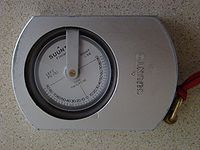.gif)
Clinometer (forestry)
Encyclopedia

Inclinometer
An inclinometer or clinometer is an instrument for measuring angles of slope , elevation or depression of an object with respect to gravity...
, is a common tool used in forestry
Forestry
Forestry is the interdisciplinary profession embracing the science, art, and craft of creating, managing, using, and conserving forests and associated resources in a sustainable manner to meet desired goals, needs, and values for human benefit. Forestry is practiced in plantations and natural stands...
to measure slope
Slope
In mathematics, the slope or gradient of a line describes its steepness, incline, or grade. A higher slope value indicates a steeper incline....
, vertical angles
Vertical (angles)
In geometry, a pair of angles is said to be vertical if the angles are formed from two intersecting lines and the angles are not adjacent. The two angles share a vertex...
, and – in combination with distance measurements – elevation change or tree heights.
How it works
A forester using a clinometer makes use of basic trigonometryTrigonometry
Trigonometry is a branch of mathematics that studies triangles and the relationships between their sides and the angles between these sides. Trigonometry defines the trigonometric functions, which describe those relationships and have applicability to cyclical phenomena, such as waves...
.
First the observer measures a straight-line distance D from some observation point O to the object. Then, using the clinometer, the observer measures the angle a between O and the top of the object. Then the observer does the same for the angle b between O and the bottom of the object. Multiplying D by the tangent of a gives the height of the object above the observer, and by the tangent of b the depth of the object below the observer. Adding the two of course gives the total height (H) of the object, in the same units as D.
Note that since multiplication is distributive it is equally valid to add the tangents of the angles and then multiply them by D:
- A = tan a
- B = tan b
- H = (A × D) + (B × D) = (A + B) × D
Note also that both angles should be positive numbers (i.e. ignore any minus sign on the clinometer's scale).
Units of measure
There are typically three different units of measure that can be marked on a clinometer: degreesDegree (angle)
A degree , usually denoted by ° , is a measurement of plane angle, representing 1⁄360 of a full rotation; one degree is equivalent to π/180 radians...
, percent, and topo. When buying a clinometer it is important to make sure it is calibrated to units suitable for the intended use.
Tree height measurement
The foresterForester
250px|thumb|right|Foresters of [[Southern University of Chile|UACh]] in the [[Valdivian forest]]s of San Pablo de Tregua, ChileA forester is a person who practices forestry, the science, art, and profession of managing forests. Foresters engage in a broad range of activities including timber...
stands at a fixed distance from the base of the tree
Tree
A tree is a perennial woody plant. It is most often defined as a woody plant that has many secondary branches supported clear of the ground on a single main stem or trunk with clear apical dominance. A minimum height specification at maturity is cited by some authors, varying from 3 m to...
. The most common distances in the United States
United States
The United States of America is a federal constitutional republic comprising fifty states and a federal district...
are 50 feet (15.24 m), 66 feet (20.12 m), and 100 feet (30.48 m). To obtain accurate readings it is best to use taped measured distance instead of paced distances
Pacing (forestry)
Pacing A reasonably easy and quick method of measuring distance in the field is by pacing . Pacing is a method used to measure a distance and is often used with a sighting or hand compass. Most commonly, pacing is split up into segments, such as chains, which are set measures of distance...
. For the most accurate readings it is best to use a distance that is not less than the height of the tree being measured., that is, that the clinometer will measure an angle less than 45° (100%).
The observer sights to the top of tree, if total height is the desired measurement. If the desired measurement is merchantable height – that is, the height producing timber that can be sold – the observer sights to a point on the tree above which no more merchantable timber is found. The observer then measures to the bottom of the tree, takes the tangents and multiples them by the distance, and adds the two figures together. This will be the height of the tree.
The observer must always measure a leaning tree so that the tree is leaning to the left or right. Measurements should never be taken with the tree leaning toward or away from the observer because this will affect their accuracy because of foreshortening.
Slope measurement

Gradient
In vector calculus, the gradient of a scalar field is a vector field that points in the direction of the greatest rate of increase of the scalar field, and whose magnitude is the greatest rate of change....
of terrain. This measurement is based on the same trigonometric principles described above. Slope measurements, however, require that both observer and target be a constant height above the ground; thus a range pole or height of measurement (HI) stick is often used in slope measurements.

